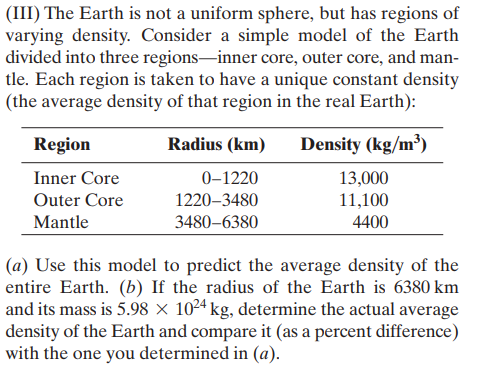(III) The Earth is not a uniform sphere, but has regions of varying density. Consider a simple model of the Earth divided into three regions-inner core, outer core, and man- tle. Each region is taken to have a unique constant density (the average density of that region in the real Earth): Region Radius (km) Density (kg/m³) Inner Core 0-1220 13,000 Outer Core 1220–3480 11,100 Mantle 3480–6380 4400 (a) Use this model to predict the average density of the entire Earth. (b) If the radius of the Earth is 6380 km and its mass is 5.98 × 1024 kg, determine the actual average density of the Earth and compare it (as a percent difference) with the one you determined in (a).
(III) The Earth is not a uniform sphere, but has regions of varying density. Consider a simple model of the Earth divided into three regions-inner core, outer core, and man- tle. Each region is taken to have a unique constant density (the average density of that region in the real Earth): Region Radius (km) Density (kg/m³) Inner Core 0-1220 13,000 Outer Core 1220–3480 11,100 Mantle 3480–6380 4400 (a) Use this model to predict the average density of the entire Earth. (b) If the radius of the Earth is 6380 km and its mass is 5.98 × 1024 kg, determine the actual average density of the Earth and compare it (as a percent difference) with the one you determined in (a).
University Physics Volume 1
18th Edition
ISBN:9781938168277
Author:William Moebs, Samuel J. Ling, Jeff Sanny
Publisher:William Moebs, Samuel J. Ling, Jeff Sanny
Chapter14: Fluid Mechanics
Section: Chapter Questions
Problem 44P: A straightforward method of finding the density of an object is to measure its mass and then measure...
Related questions
Question

Transcribed Image Text:(III) The Earth is not a uniform sphere, but has regions of
varying density. Consider a simple model of the Earth
divided into three regions-inner core, outer core, and man-
tle. Each region is taken to have a unique constant density
(the average density of that region in the real Earth):
Region
Radius (km)
Density (kg/m³)
Inner Core
0-1220
13,000
Outer Core
1220–3480
11,100
Mantle
3480–6380
4400
(a) Use this model to predict the average density of the
entire Earth. (b) If the radius of the Earth is 6380 km
and its mass is 5.98 × 1024 kg, determine the actual average
density of the Earth and compare it (as a percent difference)
with the one you determined in (a).
Expert Solution
This question has been solved!
Explore an expertly crafted, step-by-step solution for a thorough understanding of key concepts.
This is a popular solution!
Trending now
This is a popular solution!
Step by step
Solved in 3 steps with 3 images

Recommended textbooks for you

University Physics Volume 1
Physics
ISBN:
9781938168277
Author:
William Moebs, Samuel J. Ling, Jeff Sanny
Publisher:
OpenStax - Rice University

College Physics
Physics
ISBN:
9781305952300
Author:
Raymond A. Serway, Chris Vuille
Publisher:
Cengage Learning

Principles of Physics: A Calculus-Based Text
Physics
ISBN:
9781133104261
Author:
Raymond A. Serway, John W. Jewett
Publisher:
Cengage Learning

University Physics Volume 1
Physics
ISBN:
9781938168277
Author:
William Moebs, Samuel J. Ling, Jeff Sanny
Publisher:
OpenStax - Rice University

College Physics
Physics
ISBN:
9781305952300
Author:
Raymond A. Serway, Chris Vuille
Publisher:
Cengage Learning

Principles of Physics: A Calculus-Based Text
Physics
ISBN:
9781133104261
Author:
Raymond A. Serway, John W. Jewett
Publisher:
Cengage Learning

An Introduction to Physical Science
Physics
ISBN:
9781305079137
Author:
James Shipman, Jerry D. Wilson, Charles A. Higgins, Omar Torres
Publisher:
Cengage Learning

College Physics
Physics
ISBN:
9781938168000
Author:
Paul Peter Urone, Roger Hinrichs
Publisher:
OpenStax College